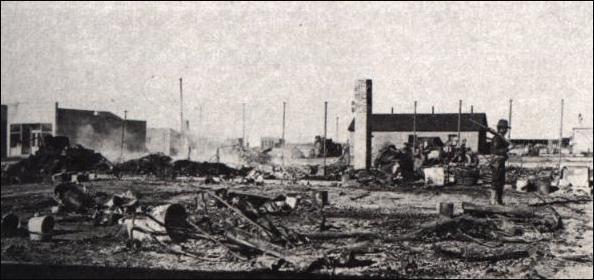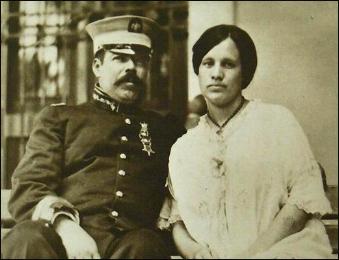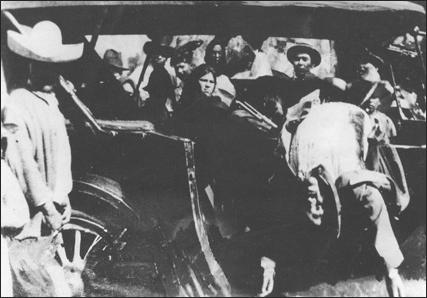Pancho Villa was both loved and hated by many. He
was a Robin Hood to some, and a cruel, cold blooded killer to others.
Who was this remarkably controversial hero of the Mexican Revolution?
There are many stories about him, including what my
grandmother and
uncle told me.
Doroteo Arango (Pancho Villa's real name) was born
at the rancho La Coyotada near San Juan del Rio, Durango on June 5,
1877, to Adrean Arango and Maria Micaela Arambula, during a
thunderstorm. This storm was later interpreted as an omen of a
tempestuous love life. In later years thunderstorms affected Villa
peculiarly. He once remarked to friend, "A storm reminds me of a battle
to live. I mean the men I have known, the slaves of the wealthy
hacendados and mine owners. I can close my eyes and see the rain beating
down on the poor field workers. Ah, the pity that some men live in
luxury while others must know belly hunger, biting cold, and the hurt of
the lash. I'll change that some day."
The boy Doroteo was from an uneducated peasant
family, and the little schooling he received was provided by the local
church-run village school. when his father died, he began to work as a
sharecropper to support his mother and four siblings. Sharecropping is a
system of agriculture production in which a landowner allows a
sharecropper to use the land in return for a share of the crop produced
on the land. It typically involves a relatively rich land owner and a
less wealthy, poor agricultural worker or farmer, although the reverse
relationship, in which a poor landlord leases to a rich tenant also
exists. The advantages of sharecropping in other situations include
enabling access for women to arable land where ownership rights are only
vested in men.
The generally accepted story states Doroteo moved
to Chihuahua at the age of 16, but promptly returned to his village
after learning that a wealthy hacienda owner had tried to sexually
assault his younger sister, who was only twelve years old. He confronted
the man, whose name was Austin Negrete, and shot him dead; then stole a
horse and dashed towards the rugged Sierra Madre mountains to escape the
police. His career as a bandit was about to begin.
He became a cattle rustler and later joined a band
of rustlers that was led by a man named Francisco "Pancho" Villa. In one
of their many skirmishes with the law, the group was surprised by a
group of mounted police (rurales) and Francisco was killed. Doroteo then
assumed command and name of the fallen leader. Perhaps he did this to
throw off those who hunted him for killing the hacienda owner, or to
assume authority over the group. From that time on he was known as
Pancho Villa. He was a natural leader and was very successful as a
bandit, leading raids on towns, killing and looting. He was also
involved in more legitimate ventures, including being a contractor on
the Copper Canyon railroad, worked as a drover of livestock, horse
trader, or head of a group of transporters, including money or valuables
for foreign, particularly American companies. The foreign interests
considered him highly reliable, and there were never any claims of theft
against him.
In 1910, when the Mexican (Madero) revolution
broke out, Villa was recruited by the revolutionary leader, Abraham
Gonzalez. Villa put together an army of armed cowboys and ruffians and
became their revolutionary general who led the war in the northern part
of Mexico. His personality and victories made him an idol of the masses.
Villa's forces were based in Chihuahua, where Villa ruled over northern
Mexico like a medieval warlord. He financed his army by stealing from
the endless cattle herds in northern Mexico and selling beef north of
the border, where he found plenty of U.S. merchants willing to sell him
guns and ammunition. Faced with a stagnant economy, he issued his own
money; if merchants refused to take it, they risked being shot.
Executions, which Villa often ordered on a whim, were usually left to
his friend Rodolfo Fierro, best known by his nickname El Carnicero
(the butcher). In true Robin Hood style, he broke up the vast land
holdings of local hacendados and parceled them out to the widows and
orphans of his fallen soldiers. There were rumors that Villa may have
been partially financed by the German imperial government, and some of
his military actions were explicitly designed to aid the Kaiser's cause.
During the early days of the revolution Villa had very good relations
with Americans. On Christmas Eve of 1912 he escaped from the military
prison of Santiago Tlatelolco in Mexico City. He had been imprisoned
after being reprieved from a death sentence handed down by General
Victoriano Huerta, the usurper who would overthrow Francisco Madero in
February 1913. That same month, Villa found himself in El Paso enjoying
freedom and countless friendships with gringos. On March 9th he crossed
the border with 15 men and started a revolt against the Huerta
dictatorship. Villa has always liked Americans and the feeling was
mutual, so among those who joined his ranks was a foreign legion of
adventurers from America. Among them was the legendary John Reed (who
wrote Insurgent Mexico), Oscar Creighton (a San Francisco bank
robber) called the Dynamite Devil, Sam Drebben (the fighting
Jew) a Spanish-speaking machinist named Ben Turner, and Edward (Tex)
O'Reilly, a tough rancher turned soldier-of-fortune, later serving in
the Philippine Insurrection and World War I.

Americans also manned Villa's primitive air force,
made up of four planes. The pilots were ex-barnstormers and just as
colorful as their comrads on the ground. They had names like Micky
McQuire, Wild Bill Heath and Farnum T. Fish. It was even rumored that
Hollywood's cowboy Tom Mix served with Villa's forces, although denied
by one El Paso journalist, who claimed it was invented by the studio's
publicist. Because of these volunteers, Villa was able to team up with
Vinustiano Carranza and Alvaro Obregon to drive Huerta into exile in
July 1914. However, the fall of Huerta didn't solve the turbulence
plaguing Mexico. Before the end of the year, Villa had fallen out with
Carranza and Obregon. Mexico was again plunged into civil war. Carranza
was installed in Mexico City as provisional president and Obregon was
his enforcer.
Obregon was a self-made, highly skilled general
who had studied trench warfare tactics used on the Western Front in
France. With this expertise, he defeated Villa and drove him from
central Mexico back to the northern sierra of Chihuahua. On October 19,
1914, the United States extended de facto recognition to Carranza.
Villa felt this was a terrible betrayal. He'd always befriended the
gringos and this was his bitter reward. Being a direct, simple man, he
didn't understand, nor accept the politics mandating that you recognize
whoever seems to effectively control the chaos of a nation. Villa was
further angered on November 2, 1915, when carrancista troops were
allowed to cross U.S. soil to attack him in the rear at Agua Prieta,
across the border from Douglas, Arizona. To add insult to injury, U.S.
searchlights were deliberately focused on the villistas to make them
easier targets for their enemies.
General Hugh L. Scott, who had many dealings with
Villa, sympathized that "the recognition of Carranza had the effect of
solidifying the power of the man who had rewarded us with kicks and
making an outlaw of the man who helped us." Villa sent Scott a telegram
saying that he was the one honest man north of the border. However, the
villistas later killed 18 American mining engineers of the ASARCO
company that they captured when they held up a train near Santa Isabel,
Chihuahua on January 10, 1914.
Now back to the German connection. At this point
we'll focus on Felix A. Sommerfeld, described by German historian
Friedrich Katz as "one of the most interesting members of the shadowy
army of agents, double agents, and lobbyists who swarmed like locusts
over Mexico once the revolution had begun." Sommerfeld was a con man.
Though he'd fought against the revolutionary Boxers in China, he came to
Mexico and convinced Madero that he was a revolutionary democrat.
Meanwhile, he was establishing close relations
with the German government and certain U.S. business interests. These
interests were represented by a crooked lobbyist named Sherbourne
Hopkins, who was closely allied with Carranza. Sherbourne befriended
Sommerfeld, gave him money, and told him to go to Mexico to work with
Carranza. The silver tongued Sommerfeld completely won Carranza's trust,
and was given the assignment to spy on Villa at Chihuahua. This he did,
but not for Carranza. All information on Villa went to the German
government. In addition, he ingratiated himself with Villa, who gave him
an exclusive concession to import diynamite for his forces. For this,
Sommerfeld received a commission of $5,000 a month. In late 1915 (a few
months before the attack on Columbus) the U.S. Justice Department
ascertained that $340,000 had been paid into Sommerfeld's bank account
in St. Louis. The money came from a German government account in New
York. When these transactions came to light, Sommerfeld closed the
account. Following the money trail, Treasury agents learned it had been
paid to the Western Cartidge Company, the arms suppliers for
Villa. When confronted by agents of the Justice Department, Sommerfeld
insisted that he had severed all relations with Villa after the U.S.
recognized Carranza, and sent Villa a telegram protesting the massacre
of the 16 mining engineers. Yet he was unable to explain why $340,000
deposited in his account by the German government had ended up in the
hands of Villa's arms supplier. Also, according to Carranza's agents in
the U.S., Sommerfeld continued to buy arms for Villa even after his
interrogation by the Justice Department. As is often the case, who was
using whom.
Pancho Villa was a revolutionary, and the fact
that he may have received arms and financial aid from the Germans
doesn't mean he embraced Kaiserism. The dominant Carranza-Obregon forces
and now hostile United States, placed Pancho Villa between a rock and a
hard place, so this time he didn't turn down help. Earlier, the German
consul in Torreon, which Villa had captured, gave a lavish banquet for
him and urged him to march on the Tampico oil fields. With the capture
of Tampico, German ships would land in the port and bring him money and
arms. Villa appeared to consider the offer, but then changed his mind
and marched on Chihuahua. His eventual acceptance of their help was not
that Pancho was a German agent, but rather a man engaged in the old game
of playing both ends against the middle.

Columbus, New Mexico after the attack.
In 1916, when an American merchant refused to
deliver the arms to Villa's army which they had paid him for, Villa
entered the United States. On the way they stopped at my grandparent's
mine. He recognized them because of her red hair that fascinated him
years earlier when he supplied meat for the mine they operated in
Mexico. This day they sat down at the kitchen table and visited for
about an hour. Before leaving, Pancho ordered his men not to harm them,
or their place. Later, the villista's attacked the 13th Cavalry,
bringing back more than a hundred of its horses and mules, a heavy load
of rifles and machine guns. The raiders also killed 26 civilians in
Columbus, New Mexico (above). United State's President Woodrow Wilson
responded to the Columbus raid by sending 6,000 troops under General
John (Black Jack) Pershing to Mexico to pursue Villa. The
President also dispatched several divisions of Army and National Guard
troops to protect the southern U.S. border against further raids and
counter-attacks. During the punitive search, the United States launched
its first air combat mission with eight airplanes. At the same time,
Villa was also being sought by Carranza's army. The U.Sl expedition was
eventually called off after failing to find Villa, who successfully
escaped from both armies.

Some sources say that on May 29, 1911 Villa
married Maria Luz Corral (left), and although he was linked with several
bogus marriages, Luz was able to produce a valid certificate proving
that she was his only legal wife. The couple had one child, a daughter,
who died within a few years. Luz had no other children, but she took in
children Villa had fathered with other women. Perhaps she felt that he
would always return to her, knowing that several of his children were
with her. Villa built the quinta (manor) during the revolution, and Luz
lived there until her death in 1981. Villa was assassinated in 1923, and
several of his alleged wives claimed the manor. The marriage
certificate might not have been sufficient to safeguard her claim, but
Luz had an important ally. During the revolution, Alvaro Obregon had
visited had visited the Villas at the quinta. There Villa had plotted to
have Obregon killed, but Luz had interceded, saving the future
president's life. The favor was not forgotten, and Obregon used his
considerable influence to protect Luz's claim.
Sharing her memories, eighty-two year old Dona Luz
told of her life as a child, living with her widowed mother in the town
of San Andres. One day, when she was a teenager, Villa and his soldiers
rode in and demanded monetary contributions from the townspeople. Her
mother asked to be excluded, and Villa visited her small store to see if
she was really as poor as she claimed to be. There he met Luz. The
courtship was very brief, and over the objections of her mother, Luz
married Villa. The attending priest asked Villa to make his confession.
The General declined, stating that it would take days to list all his
sins.
Obregon overthrew Carranza in 1920, and while
fleeing to Veracruz, Carranza was assassinated. While Obregon was
preparing to run for president, the interim chief executive, Adolfor de
la Huerta signed a peace treaty with Villa on July 28, 1920. Willa
surrendered and retired from the revolution. He was given a hacienda in
Canutillo, and an annual pension. Many attempts were made on Villa's
life by relatives of persons he'd killed. On July 20, 1923, fourteen men
waited for Villa near the town plaza at Parral, Chihuahua. They were
hiding in trees and on rooftops.

As Villa's black Ford turned the corner, the
mercenaries let loose a volley that killed the three occupants, and left
50 bullet wounds (mostly around the heart) in the body of the seemingly
invincible bandit-revolutionary. They wanted to make sure he couldn't
survive, because the legend was that "He would get shot, fall off his
horse and get up again time after time; that Villa had a deal with the
devil." In reality, Villa had created a bulletproof vest out of the
skins of black sheep. He'd stopped wearing it when he retired to his
hacienda, and became the region's benefactor.
Hailed as a hero of the Mexican Revolution, the
charismatic Villa brought 300 street children from Mexico City to
Chihuahua and housed and educated them in a boarding school orphanage.
He parceled out land his army had taken from hacienda owners to widows
and children and opened a school of agriculture. He may have been a bank
robber, cattle rustler and murderer in his youth, but that didn't stop
the people of Parral from worshipping Villa. They paraded past his body,
lying in state on a hotel balcony, and mourned his death.
So ended the passionate life and visions of Pancho
Villa about whom author John Reed wrote..."This ignorant fighter, not
educated enough to be the President of Mexico." He told it to me once
in these words: "When the new Republic is established there will never
be any more army in Mexico. Armies are the greatest support of tyranny.
There can be no dictator without an army. We will put the army to work.
In all parts of the Republic we will establish military colonies
composed of the veterans of the Revolution. The State will bive them
grants of agricultural lands and establish big industrial enterprises to
give them work. Three days a week they will work and work hard, because
honest work makes good citizens. And the other three days they will
receive military instruction and go out and teach all the people how to
fight. Then when the Patria is invaded, we will just have to telephone
from the palace at Mexico City, and in half a day all the Mexican people
will rise from their fields and factories fully armed, equipped and
organized to defend their children and their homes. My ambition is to
live my life in one of those military colonies among my companeros whom
I love, who have suffered so long and so deeply with me. I think I would
like the government to establish a leather factory there where we could
make good saddles and bridles, because I know how to do that; and the
rest of the time I would like to work on my little farm, raising cattle
and corn. It would be fine, I think, to help make Mexico a happy place."
Back